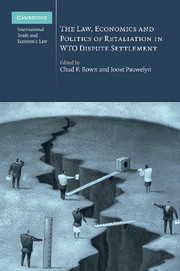Book contents
- Frontmatter
- Contents
- List of tables and figures
- Contributors
- Introduction: trade retaliation in WTO dispute settlement: a multi-disciplinary analysis
- PART I Background and goal(s) of WTO retaliation
- PART II A legal assessment after ten arbitration disputes
- PART III An economic assessment after ten arbitration disputes
- PART IV The domestic politics and procedures for implementing trade retaliation
- PART V Problems and options for reform
- 15 Evaluating the criticism that WTO retaliation rules undermine the utility of WTO dispute settlement for developing countries
- 16 Optimal sanctions in the WTO: the case for decoupling (and the uneasy case for the status quo)
- 17 Sanctions in the WTO: problems and solutions
- 18 WTO retaliatory measures: the case for multilateral regulation of the domestic decision-making process
- 19 The WTO Secretariat and the role of economics in panels and arbitrations
- 20 The equivalence standard under Article 22.4 of the DSU: a ‘tariffic’ misunderstanding?
- PART VI New frontiers and lessons from other fields
- Index
20 - The equivalence standard under Article 22.4 of the DSU: a ‘tariffic’ misunderstanding?
Published online by Cambridge University Press: 26 February 2010
- Frontmatter
- Contents
- List of tables and figures
- Contributors
- Introduction: trade retaliation in WTO dispute settlement: a multi-disciplinary analysis
- PART I Background and goal(s) of WTO retaliation
- PART II A legal assessment after ten arbitration disputes
- PART III An economic assessment after ten arbitration disputes
- PART IV The domestic politics and procedures for implementing trade retaliation
- PART V Problems and options for reform
- 15 Evaluating the criticism that WTO retaliation rules undermine the utility of WTO dispute settlement for developing countries
- 16 Optimal sanctions in the WTO: the case for decoupling (and the uneasy case for the status quo)
- 17 Sanctions in the WTO: problems and solutions
- 18 WTO retaliatory measures: the case for multilateral regulation of the domestic decision-making process
- 19 The WTO Secretariat and the role of economics in panels and arbitrations
- 20 The equivalence standard under Article 22.4 of the DSU: a ‘tariffic’ misunderstanding?
- PART VI New frontiers and lessons from other fields
- Index
Summary
Synopsis of the argument
A systematic study of the ‘equivalence standard’ in WTO arbitrations under Article 22.4 of the Dispute Settlement Understanding (DSU) has so far been wanting in WTO scholarship and in the practice of Dispute Settlement Body (DSB) arbitrators. 1 Article 22.7 of the DSU mandates the WTO arbitrator to ‘determine whether the level of [suspension of concessions or other obligations] is equivalent to the level of nullification or impairment’. Decomposing this standard into its constituent parts, and assessing the tasks of the arbitrator, namely:
– quantification of the level of nullification or impairment (NoI) according to the nature, form and intensity of the offending measure;
– quantification of the level of suspension of concessions or other operations (SCOO) according to the nature, form and intensity of remedial action;
– safeguarding equivalence between the two levels
we bring forth three independent claims.
First, when assessing the level of NoI, WTO arbitrators systematically utilized an inappropriate damage measure, or baseline counterfactual, with which the actual situation of the complainant is to be compared. Under the current practice, arbitrators compare the actual breach-ridden situation with a counterfactual that would prevail if the illegality were removed after the reasonable period of time (RPT). This counterfactual may be apt to re-establish the status quo ante the breach, yet it is not suited to compensate the complainant for its true damage suffered from the violation of the contract. Contract theory would mandate that NoI be calculated based on a counterfactual that puts the injured party in as good a position as it would have been if the violating party had performed as promised (‘expectation damages’).
- Type
- Chapter
- Information
- Publisher: Cambridge University PressPrint publication year: 2010
- 1
- Cited by

